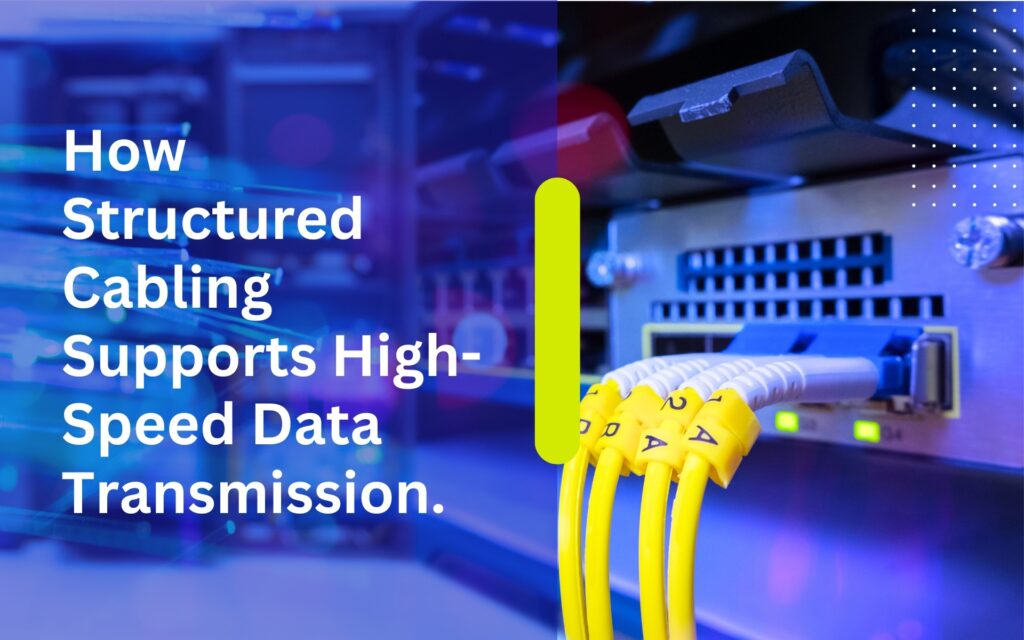Celebrating a Year of Growth and Success at InstallersPH IT Solutions. Introduction. As the year comes to a close, InstallersPH IT Solutions takes a moment to reflect on a journey defined by …
How Structured Cabling Supports High-Speed Data Transmission.

Introduction
In today’s fast-paced digital landscape, characterized by the relentless expansion of technology and the ever-increasing demand for seamless connectivity, high-speed data transmission has emerged as a critical necessity across diverse sectors. From multinational corporations to small businesses, educational institutions, healthcare facilities, and entertainment venues, the ability to transfer data swiftly and reliably is essential for maintaining competitiveness, productivity, and operational efficiency. At the heart of this capability lies structured cabling, a foundational element that forms the backbone of modern network infrastructure.
Structured cabling serves as the fundamental framework upon which data communication systems are built, providing the essential physical infrastructure necessary for transmitting information within and between organizations. It encompasses a comprehensive and standardized approach to organizing, deploying, and managing cables, connectors, and associated hardware components. Unlike ad-hoc cabling arrangements, structured cabling follows a systematic design methodology that optimizes performance, scalability, and reliability across diverse communication mediums, including voice, data, and video.
In essence, structured cabling serves as the nervous system of modern networks, enabling the seamless exchange of data across disparate devices, platforms, and locations. Its structured approach not only facilitates efficient data transmission but also simplifies network management and troubleshooting, thereby enhancing overall operational agility and responsiveness. By establishing a unified and standardized infrastructure, structured cabling minimizes complexity, reduces downtime, and fosters interoperability between disparate systems and technologies.
Structured cabling is not merely a passive conduit for data transmission but a strategic asset that empowers organizations to adapt and thrive in an increasingly interconnected world. Its modular design and standardized protocols enable organizations to scale their network infrastructure rapidly in response to evolving business needs and technological advancements. Moreover, structured cabling lays the foundation for future-proofing, allowing organizations to integrate emerging technologies seamlessly without the need for costly and disruptive infrastructure upgrades.
In the following comprehensive guide, we will delve deeply into the multifaceted role of structured cabling in facilitating high-speed data transmission. We will explore its key features, advantages, and considerations for optimizing performance, providing invaluable insights for organizations seeking to leverage structured cabling to enhance their network infrastructure. Through a thorough examination of best practices, emerging trends, and real-world case studies, we aim to equip readers with the knowledge and tools necessary to harness the full potential of structured cabling in the digital age.
Structured Cabling
Structured cabling comprises a hierarchical system of cables and connectivity products designed to facilitate the seamless transmission of data across a network infrastructure. Unlike traditional point-to-point cabling systems, which can be complex and difficult to manage, structured cabling offers a more organized and scalable approach.
At its core, structured cabling consists of several essential components:
1. Cables
The backbone of any cabling infrastructure, cables carry data signals between devices. Common types of cables used in structured cabling include twisted pair copper cables (such as Cat5e, Cat6, and Cat6a) and fiber optic cables.
2. Patch Panels
Patch panels serve as central distribution points for connecting cables from various network devices, such as computers, servers, and switches. They provide a convenient and accessible interface for managing cable connections.
3. Connectors and Jacks
Connectors and jacks are used to terminate cables and establish connections between network devices and the cabling infrastructure. Examples include RJ45 connectors for Ethernet cables and SC or LC connectors for fiber optic cables.
4. Racks and Cabinets
Racks and cabinets house networking equipment and cabling components in a structured and organized manner. They help optimize space utilization and provide physical security for sensitive hardware.
5. Cable Management Systems
Cable management systems, such as cable trays, racks, and ties, are employed to organize and route cables neatly within a data center or telecommunications room. Proper cable management minimizes signal interference and facilitates troubleshooting.
Supporting High-Speed Data Transmission
Structured cabling plays a pivotal role in supporting high-speed data transmission by providing several key benefits:
1. Reliability
Structured cabling installations adhere to industry standards and best practices, ensuring reliable performance and minimizing the risk of signal degradation or loss. This reliability is essential for maintaining consistent data transmission speeds, particularly in mission-critical environments.
2. Scalability
As organizations grow and their data transmission requirements evolve, structured cabling offers scalability and flexibility. Its modular design allows for easy expansion and modification without the need for extensive rewiring, reducing both downtime and costs.
3. Performance
Structured cabling systems are engineered to deliver optimal performance, supporting high-speed data transmission rates required for bandwidth-intensive applications such as video streaming, cloud computing, and virtualization. By minimizing signal attenuation and electromagnetic interference, structured cabling maximizes throughput and minimizes latency.
4. Future-Proofing
Investing in a well-designed structured cabling infrastructure ensures future-proofing against technological advancements and emerging standards. With proper planning and implementation, organizations can adapt to evolving technologies and protocols without requiring major infrastructure overhauls.
Optimizing Structured Cabling for High-Speed Transmission
While structured cabling inherently supports high-speed data transmission, optimizing its performance requires careful planning and adherence to best practices:
1. Design Considerations
A thorough understanding of the organization’s current and future networking needs is essential for designing an effective structured cabling system. Factors to consider include anticipated data volumes, growth projections, equipment placement, and environmental considerations.
2. Cable Selection
Choosing the appropriate type and category of cables is critical for achieving optimal performance. Factors such as transmission distance, bandwidth requirements, and electromagnetic interference should inform cable selection decisions.
3. Installation Quality
Proper installation practices are paramount to ensuring the integrity and performance of structured cabling systems. Cables should be installed and terminated according to manufacturer specifications and industry standards to minimize signal loss and maintain signal integrity.
4. Cable Management
Effective cable management is essential for minimizing signal interference and simplifying troubleshooting efforts. Employing cable trays, racks, and labels helps organize cables and facilitate airflow, reducing the risk of overheating and equipment failure.
5. Regular Maintenance
Ongoing maintenance and periodic inspections are necessary to identify and address potential issues before they escalate. This includes checking for cable damage, verifying connections, and updating documentation as changes are made to the cabling infrastructure.
Conclusion
Structured cabling stands as the cornerstone of contemporary data transmission systems, offering not just a conduit for information but a strategic framework that supports the complex needs of modern networking environments. Its significance lies not only in its ability to facilitate high-speed data transmission but also in its capacity to provide a robust infrastructure that can adapt and grow alongside evolving technological demands.
Reliability, as underscored by structured cabling, is more than just a desirable trait; it’s a fundamental requirement for any organization reliant on uninterrupted data flow. By adhering steadfastly to industry standards and best practices, organizations instill confidence in their network infrastructure’s ability to withstand the rigors of daily operation. This reliability ensures that critical data can be transmitted without interruption, fostering operational continuity and safeguarding against costly downtime.
Moreover, the scalability inherent in structured cabling is a key asset in an era defined by rapid digital expansion. Businesses today operate in a dynamic landscape where growth is not just desirable but imperative for staying competitive. Structured cabling accommodates this growth seamlessly, providing a framework that can be easily expanded and upgraded to meet evolving needs. Whether it’s adding new workstations, integrating advanced technologies, or expanding into new facilities, structured cabling offers the flexibility to scale infrastructure without sacrificing performance or reliability.
Performance optimization is another crucial aspect of structured cabling that cannot be overlooked. In a world where data is the lifeblood of organizations, the ability to transmit information swiftly and efficiently is paramount. Structured cabling systems are meticulously designed and implemented to minimize signal degradation, mitigate interference, and maximize throughput. By leveraging high-quality components and adhering to rigorous installation standards, organizations can ensure that their cabling infrastructure operates at peak performance, delivering the speed and reliability necessary to support mission-critical operations.
Furthermore, the adherence to industry standards and best practices is not merely a recommendation but a strategic imperative for organizations looking to maximize the return on their investment in cabling infrastructure. Standards such as TIA/EIA-568 and ISO/IEC 11801 provide a blueprint for excellence, guiding organizations in the design, installation, and maintenance of their cabling systems. By embracing these standards, organizations can future-proof their infrastructure, minimize compatibility issues, and streamline troubleshooting efforts, thereby enhancing overall operational efficiency and reducing total cost of ownership.
In conclusion, structured cabling is not just a means to an end; it’s a foundational element that shapes the reliability, scalability, and performance of modern networking environments. By embracing structured cabling and adhering to industry standards and best practices, organizations can build infrastructure that not only meets the demands of today but also anticipates the challenges of tomorrow. In doing so, they ensure seamless connectivity, optimal performance, and enduring value for years to come.
Related Articles
Notice to the Public: Holiday Vacation Advisory of InstallersPH IT Solutions. Introduction. InstallersPH IT Solutions is committed to providing reliable and professional IT services to all our valued clients and partners. As …
The On-the-Job Training Experience of Sherlyn Linao. Introduction On-the-Job Training (OJT) is an essential part of a student’s academic development, providing practical exposure to real workplace environments. It allows interns to apply …



